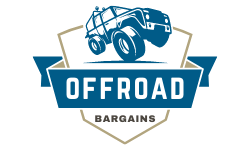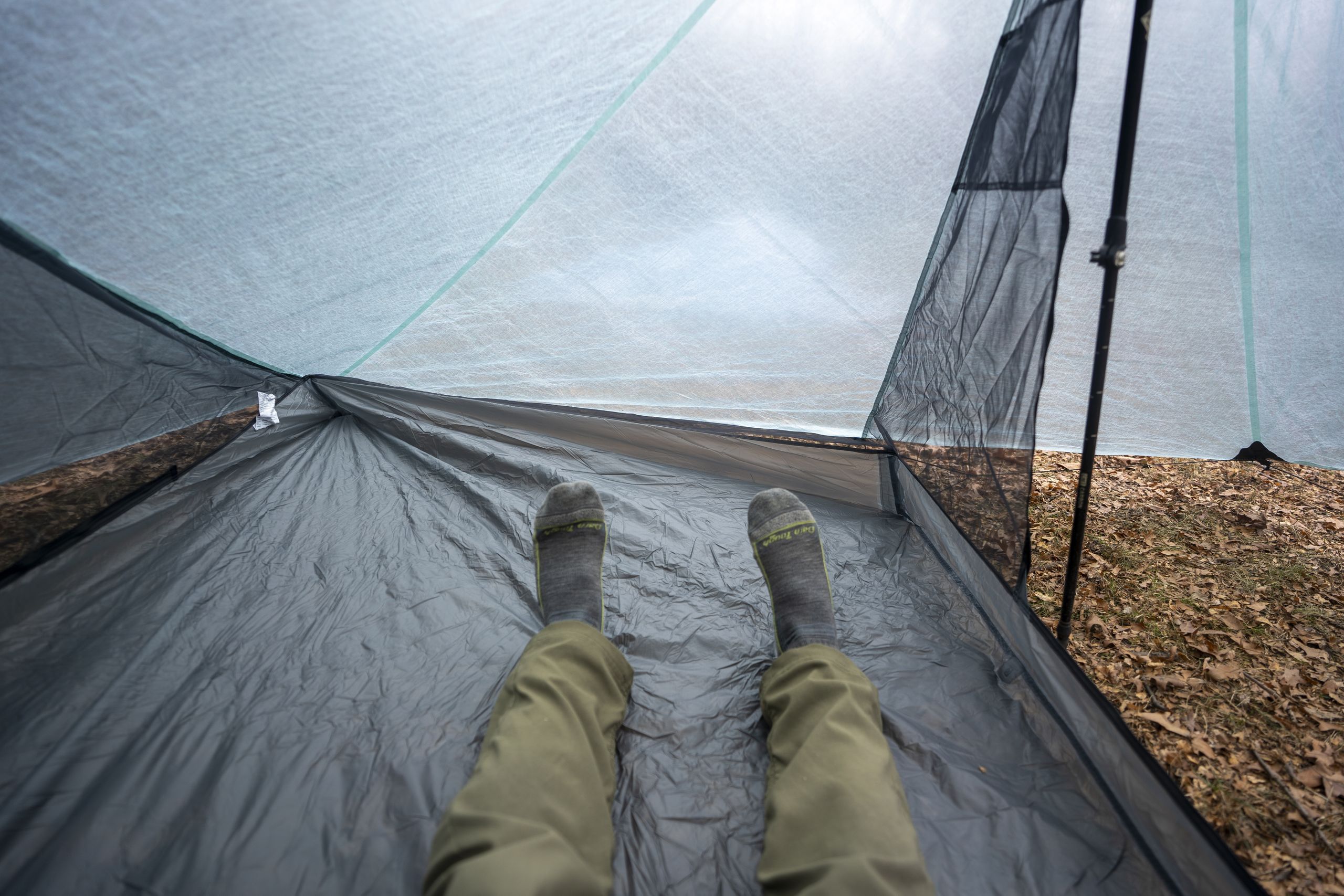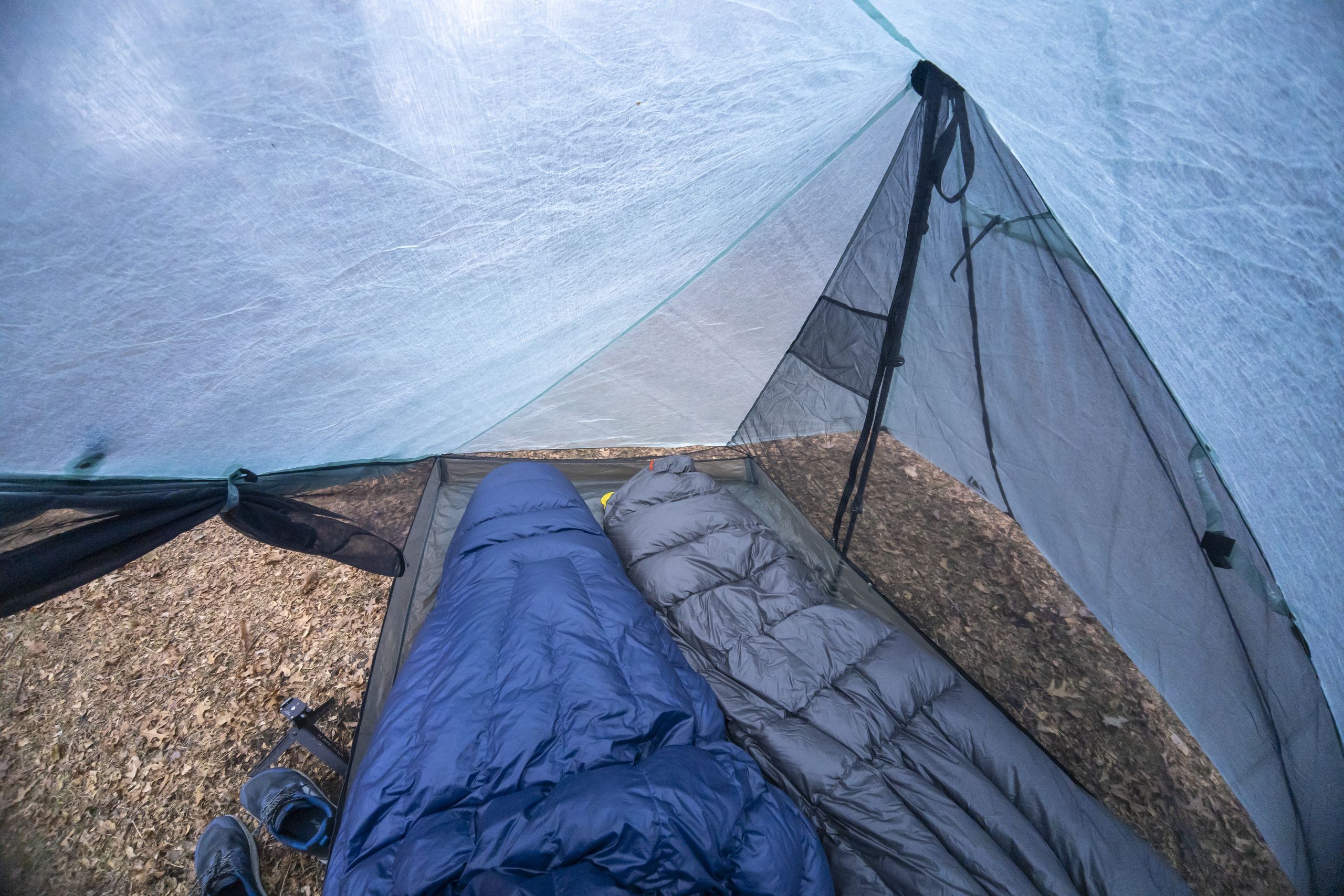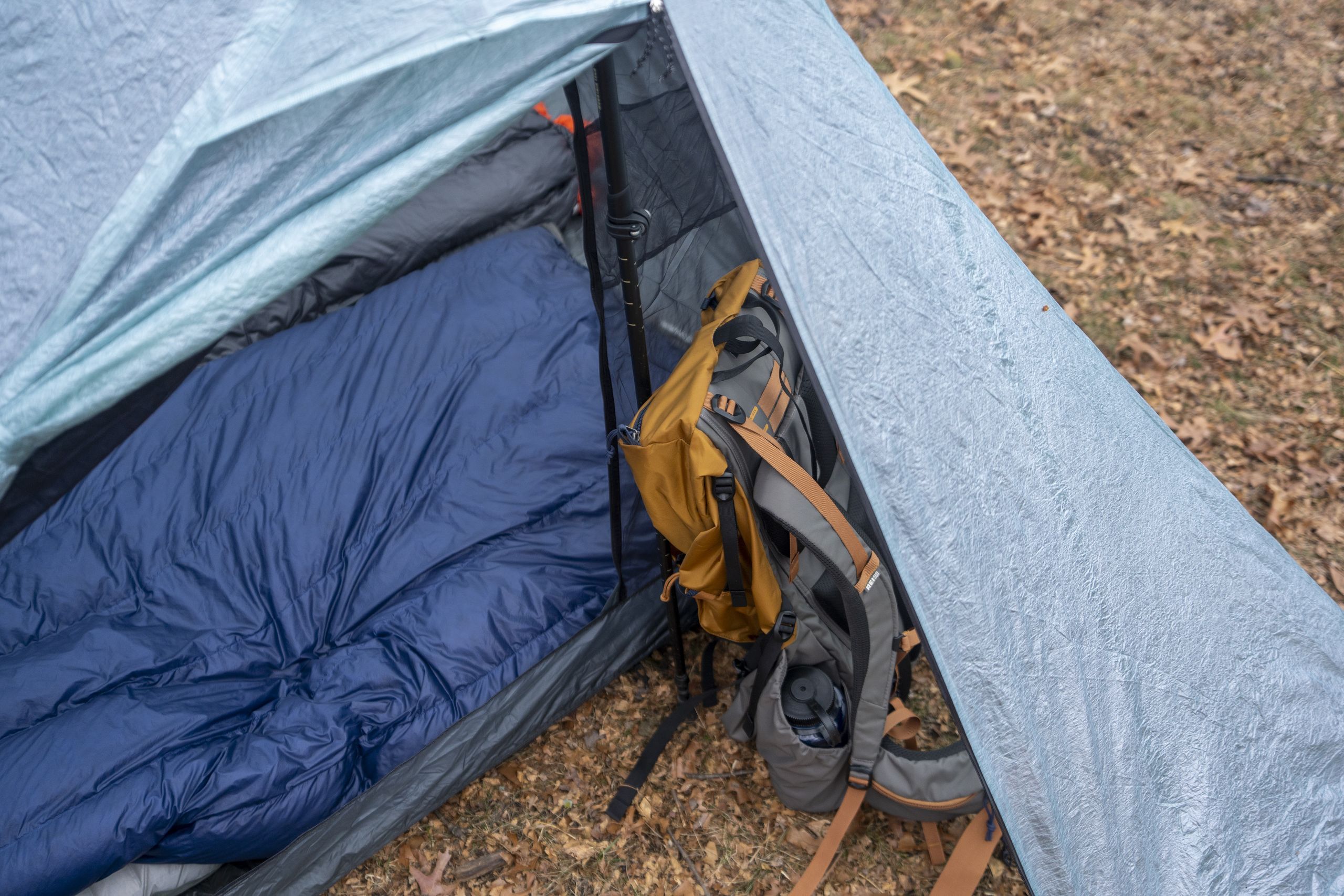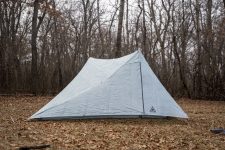
Durston X-Mid Pro 2+ Tent Review
Bottom Line
Few tents balance comfort and weight as well as the X-Mid Pro 2+. Among all the tents in our lineup of the best ultralight options, this one delighted us the most, making it our top pick for adventures with two people. The first time we entered, we were astounded by the amount of space- not just the floor space, but actual livable space. We easily fit two lofty sleeping quilts inside without worrying about touching the head and foot ends. Combined with excellent doors, vestibules, pockets, ventilation, and easy setup, it was effortless to fall in love with this tent.
Although Durston Gear is a relatively new company, they have been steadily gaining popularity on long-distance trails thanks to a combination of excellent design and competitive prices. The Pro 2+ is their most premium model, featuring a larger design than the standard Pro 2.
After testing it in the local forests of Minnesota, we found ourselves dreaming of our next big adventure with this tent more than with any other we tested. The design plays a significant role in this success; the Pro 2+ employs an offset pole geometry to maximize internal volume more effectively than other two-pole setups. This same design also allows for easy setup, requiring only four stakes for a basic pitch.
The price will still be a barrier for many people. Like all DCF tents, there’s no avoiding the fact that a tent made from costly fabrics will also be expensive. Fortunately, the option of a silnylon floor helps reduce the price a bit, making it more affordable than other tents in this weight range.
In the end, we’re left with a tent that balances the important aspects of tent design better than any other we’ve tested. Every part feels thoughtfully and cleverly designed, and the few negatives we encountered are intentional design trade-offs to enable a better experience elsewhere. For the way we backpack, this is the one shelter we’d choose if we wanted a delightfully comfortable experience at a weight that makes our backs grin.
Quick Specs
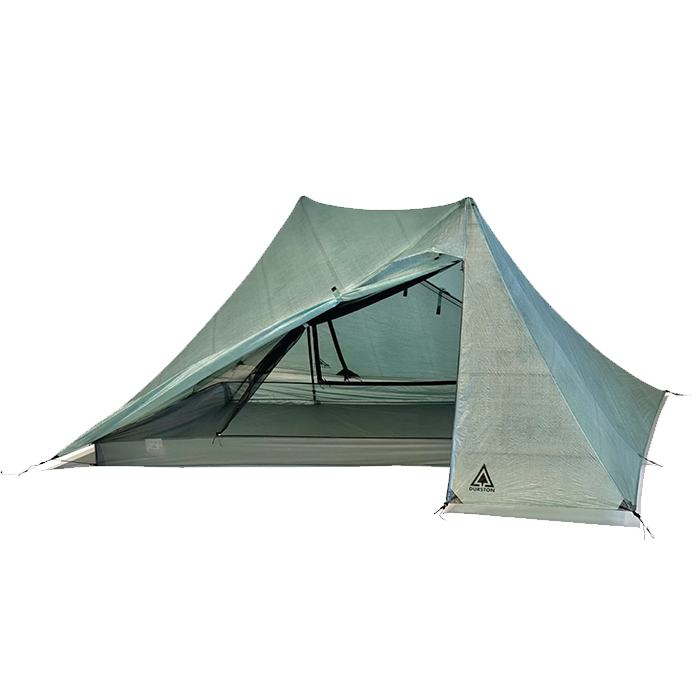
Durston Gear X-Mid Pro 2+
Best Two-Person Ultralight Tent
CleverHiker Rating:
4.9/5.0
Price:
$669
Weight:
1 lb. 5.8 oz.
Dimensions (LxWxH):
92 x 52 x 49 in.
Floor Area:
32.5 sq ft
Pros
- Incredible livability for two people
- Easy set-up
- Great ventilation
- Large vestibules
- Large pockets
Cons
- Alternate pitching styles require some work
- Expensive
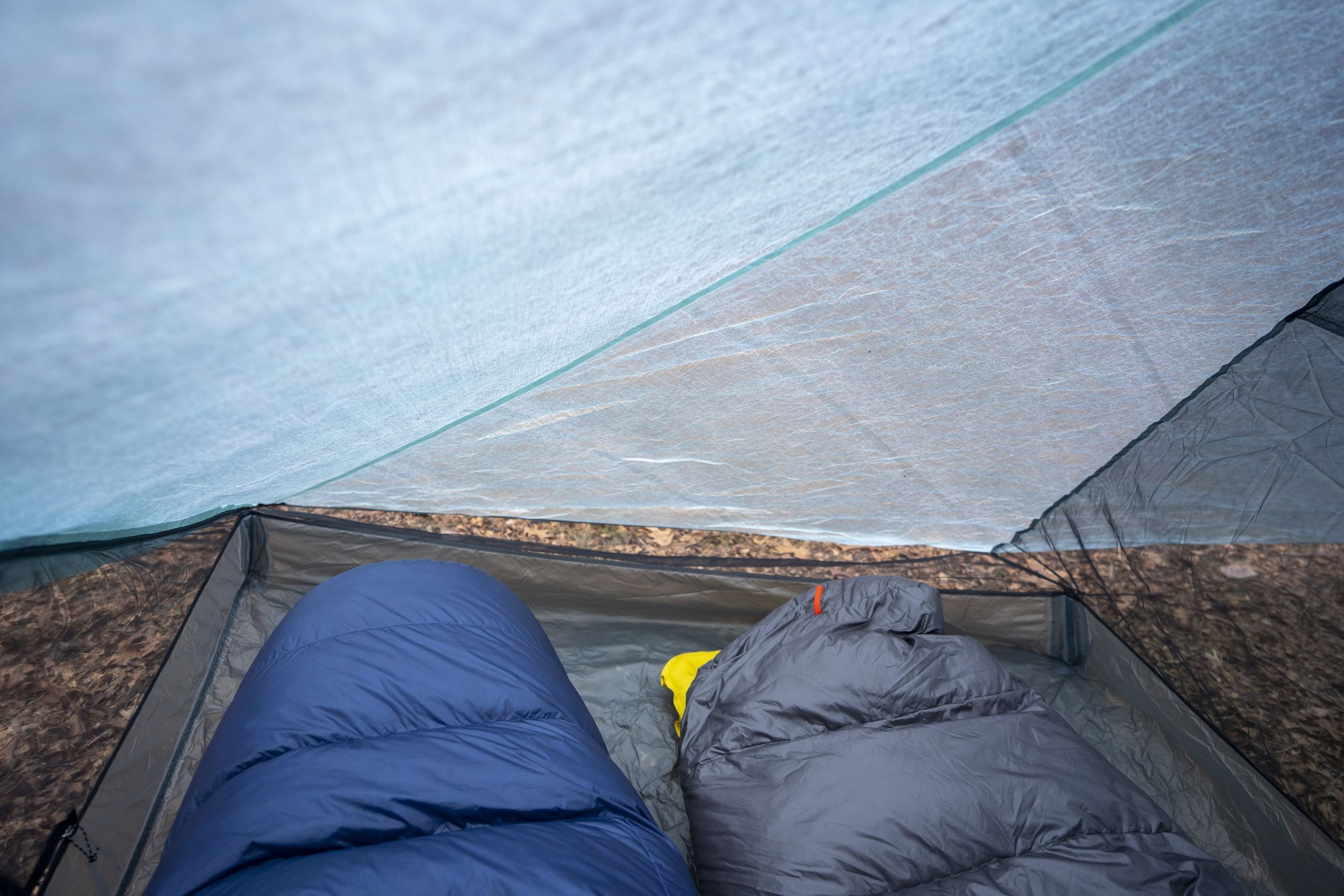
Comfort
With a generous 32.5 square feet of floor space and a lofty 49 inches of height in an offset pole design, the X-Mid Pro 2+ is the most comfortable and spacious tent in our lineup. For its weight, there’s no other tent we’d rather spend our nights in. Perhaps the biggest testament to this is what we experienced during our first setup of the shelter.
After testing many other smaller tents, the first time we crawled into the Pro 2+, we literally laughed at how much headroom there was and the seemingly ridiculous amount of livable space. Compared to most other ultralight tents, the Pro 2+ felt like a breath of fresh air for space. We were able to comfortably fit a two-person setup with plush three-season quilts and 2.5-inch sleeping pads into the interior with plenty of headroom and footroom. There was enough room that if you and your tent buddy are around six feet tall, anxiety about a wet footbox or cramped headroom is a thing of the past.
Part of what makes this tent so effective is the previously mentioned offset pole design. Durston Gear has an entire whitepaper that delves into the specifics of tent design and volumetrically efficient geometry. In summary, the offset design is optimized to provide the most livable interior space possible in a two-pole configuration. We have firsthand experience with manufacturers making bold but unsubstantiated claims about their tents, particularly regarding their ability to accommodate taller individuals, but we are pleasantly surprised by Durston Gear’s design in this case. It genuinely seems to offer a generous amount of livable interior space with a two-pole design, especially when compared to a classic A-frame.
That said, just because the X-Mid has math on its side doesn’t make it perfect. The downside of an offset pole design like this is that it’s inherently asymmetrical. This means that if both people are sleeping head to head, one person will end up with a sloping wall closer to their face than the other.
We were cautious about this when testing, but were pleasantly surprised by the amount of headroom available when sleeping in the non-ideal orientation. Frankly, it’s even more than when sleeping in other shelters in the correct orientation, and we’re thankful that the design accommodates both types of sleeping orientations.
Several small yet thoughtful design features enhance comfort. The large sidewall pockets are easy to use, and the spacious L-shaped doors allow effortless access regardless of your lying position. The headroom is impressive, partially due to the 49-inch peak height but also thanks to the extended diagonal of sustained headroom, which offers a more livable experience compared to a single peak.
Lastly, the vestibules are enormous and fantastic. We appreciated being able to lean our backpacks against the trekking poles at night to prevent them from falling over, while still having the area protected by the smaller vestibule even when the main door was open. They are convenient for any sleeping orientation and provide excellent splashback protection since the fly extends nearly to the ground.
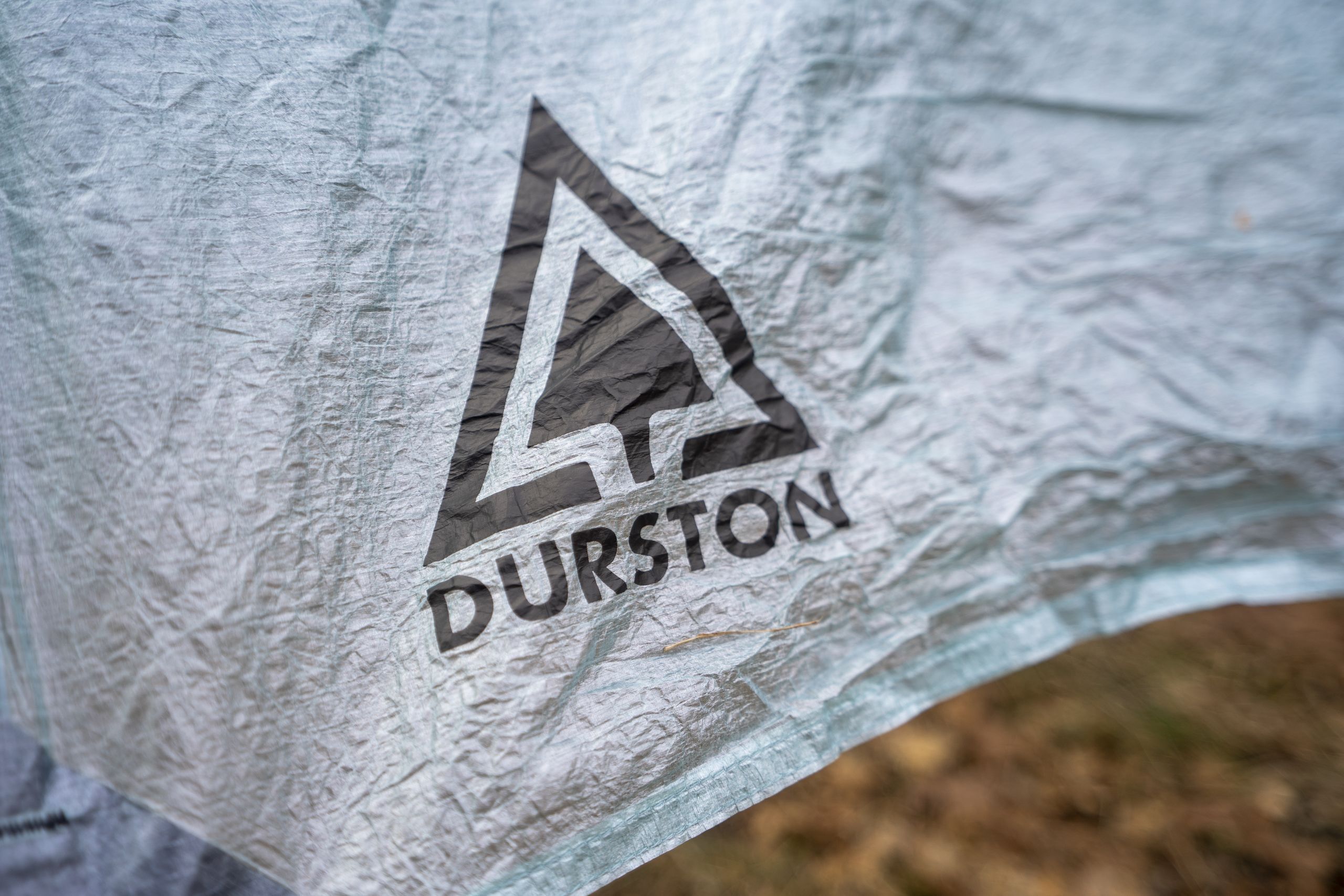
Weight
We measured the Pro 2+ at 21.8 ounces on our scales, which is impressive for a tent that offers this much comfort. There are actually two versions of this tent available, and their weights differ. The version we’re testing features a silnylon floor instead of a Dyneema Composite Fiber floor. This adds two extra ounces but saves $100, which we believe is a decent trade that most people would accept.
Additionally, we appreciate that silnylon packs down a bit smaller than DCF, making the packed size of a large shelter like this more manageable.
The Pro2+ isn’t the lightest two-person shelter on the market, but it’s also not aiming to be. The inclusion of a plus in its name suggests that it targets a more comfortable experience for those who prioritize comfort over having the lightest weight tent available.
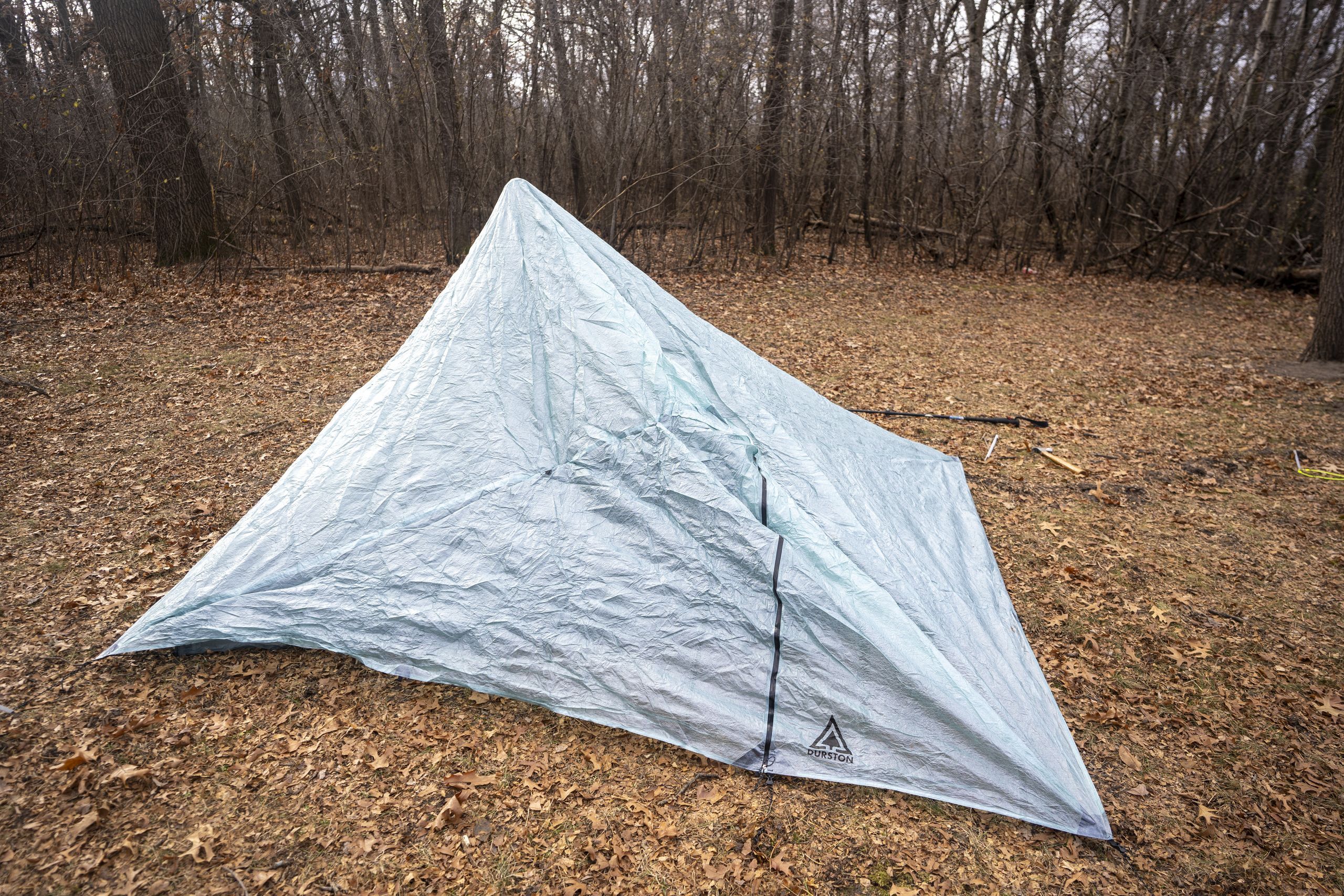
Ease of Use
With only four stakes and two trekking poles needed to pitch the tent, we found the Pro 2+ quite easy to set up and use. For those who haven’t used a trekking pole shelter before, setup will require some adjustment, so we recommend practicing at home a few times before taking it on an adventure. However, among trekking pole tents, the Pro 2+ makes it relatively simple. Stake out a rectangle using the two corners, push up the two trekking poles into the peaks, and you’re done.
The downside of this simplicity is that you need to ensure the rectangle is square; otherwise, the pitch will be uneven. Leaving a few inches of cord in either direction with the corner Lineloc tensioners allows for adjustments to rectify this, but you may need to re-stake to achieve a good pitch. Although four stakes are the minimum, we recommend carrying two more so the doors can be staked out for convenient one-handed opening and closing.
One advantage of the design is that when inserting the trekking poles into the rainfly, they can stand on their own. Many other tents require an additional stake while stabilizing the pole until three points of tension can secure it, but the Pro 2+ does not have this issue.
On the negative side, the choice to have the rainfly extend so close to the ground limits the shelter’s versatility on uneven terrain. We understand the design choice – the low rainfly offers excellent protection from wind and rain – but it represents another trade-off in optimizing a tent’s design. When testing other X-Mid tents with the same limitation, we’ve set them up on rocky ledges and various uneven surfaces, consistently finding ways to make them functional, so we don’t consider this to be a significant drawback.
Additionally, the footprint is quite large. The issue arises mainly because its rectangular shape makes it more challenging to fit into natural spots compared to shelters with a more hexagonal design. Given the amount of interior and vestibule space available, there’s no avoiding the large footprint; bigger tents are inherently harder to position in tight spaces. However, Durston Gear provides guides for alternative pitching methods that can collapse the vestibules, offering a considerably reduced footprint size when space constraints arise, which adds a nice versatility bonus.
On the interior, using the tent is similarly easy. The doors are large and comfortable for entering and exiting.The closure mechanisms for both the rainfly and mesh doors are all magnetic which makes securing and closing them a breeze. And the peak vents can be propped open with a kickstand from inside the tent, which makes it super easy to use.
Speaking of those peak vents, they also enable another neat trick. Instead of unzipping the door to place a trekking pole, you can pass it through the peak vent and angle it up into the peak. This is advantageous in rainy weather, as it helps minimize rain entering the interior, or in desert conditions, where reducing zipper use is crucial to prevent failure.
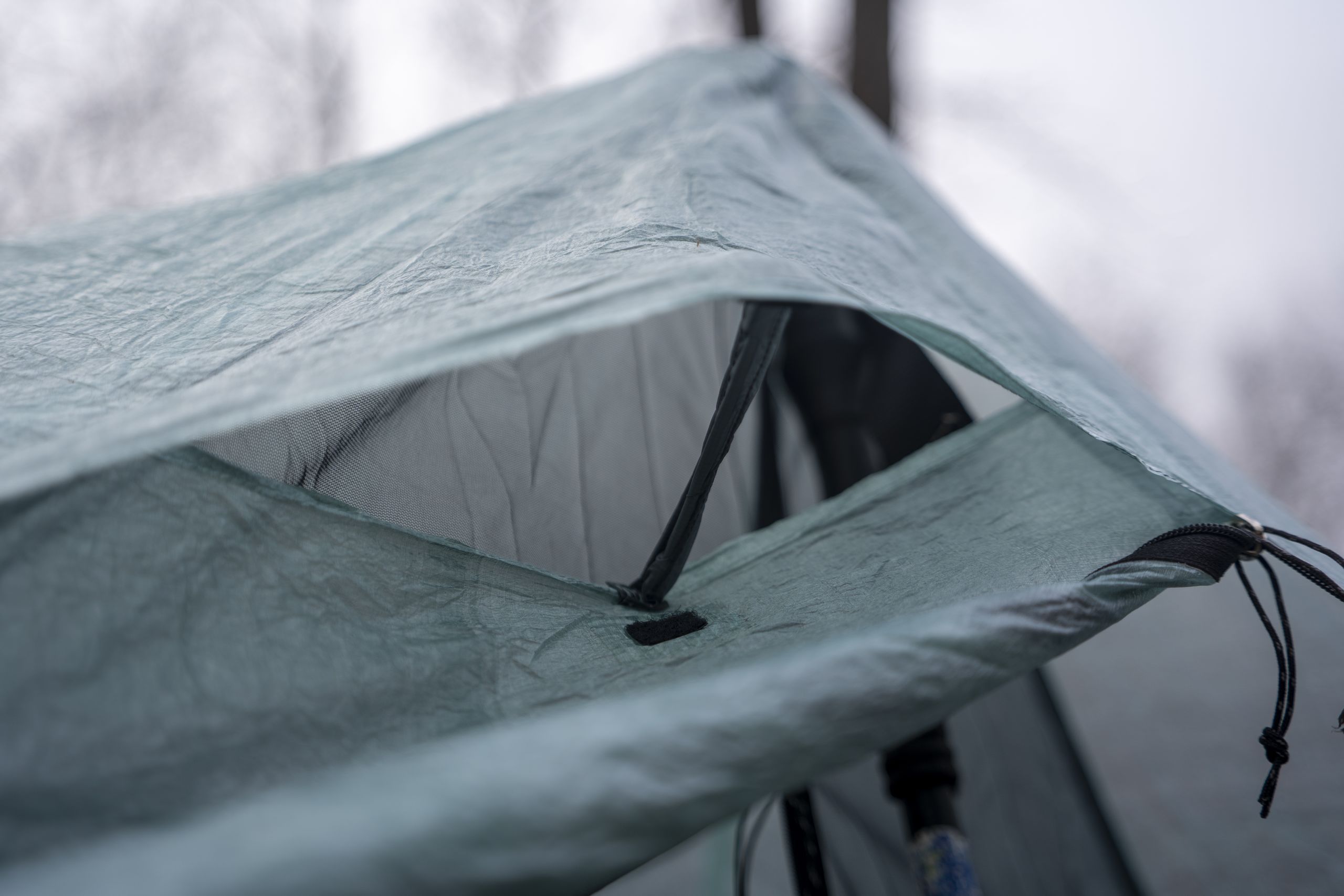
Weather Resistance
With a design that effectively sheds wind and a rainfly that reaches all the way to the ground, the Pro 2+ is one of our favorite shelters for weathering a storm. The offset pole geometry helps disrupt the large side panels that often challenge A-frame style tents. There are still attachment points midway up the sides and at the peak, which can significantly aid in resisting strong winds.
The DCF fabric used in the rainfly is an excellent material for weather resistance. It features minimal stretch and offers outstanding water resistance due to its construction. Unlike silnylon, it does not absorb water and sheds it easily, making it quick to dry and ensuring it won’t weigh down your pack after getting wet.
Although we overall love the Pro 2+ for storms, it remains a large shelter. If winds strike it from the side, it will struggle more, just like any other tent. It’s important to try to orient it with the peak ridgeline facing into the wind for optimal performance. We can’t complain too much here, as comparable tents will also perform poorly when hit from the side and do not possess as good a profile for cutting through the wind when oriented properly.

Durability
With 0.55oz/sq yd DCF for the fly and 15D silnylon for the floor, the Pro 2+ boasts acceptable durability for an ultralight tent and aligns with its peers and our criteria for a tent in this category. DCF is an excellent material for rain flies, and the tensile strength of the fabric has been tested over time on many of the longest trails.
The 15D silnylon floor is an interesting choice for reducing cost and packed size. According to testing conducted by Durston Gear, it performs similarly to 1.0 oz/sq yd DCF as a floor material, though they offer both options.
In our testing, we found that the 15D silnylon used by Durston Gear holds up well against the rigors of a thru-hike. We carried an X-Mid Pro 1 with the same 15D floor for 1,000 miles on the PCT. One night, we accidentally set up on a sharp, abrasive granite rock and woke up to deformation in the silnylon but no tears or punctures.
After allowing the fabric some time to relax, it returned to its original shape. We’re still going to treat the material with a bit more care than the 20D or 30D floors found in other shelters, but we’re pleased with its performance.

Should You Buy the X-Mid Pro 2+?
If you’re in the market for a supremely comfortable backpacking tent that boasts great weather resistance at an incredible weight, we believe the X-Mid Pro 2+ should be at the top of your list. No other tent impressed us as much during testing. It’s the one we want to grab for nearly every adventure with another person. Rather than dreading crawling into a cramped interior, the Pro 2+ is spacious enough to make even taller users sigh with relief.
All that performance and comfort come at a cost, and like all DCF tents, the Pro 2+ is expensive. To its credit, it’s actually on the less expensive side of this class of tent owing to the silnylon floor option, but even with that it’s a chunk of change. For someone embarking on a thru-hike with another person, we believe it’s a worthwhile investment in long-term comfort.
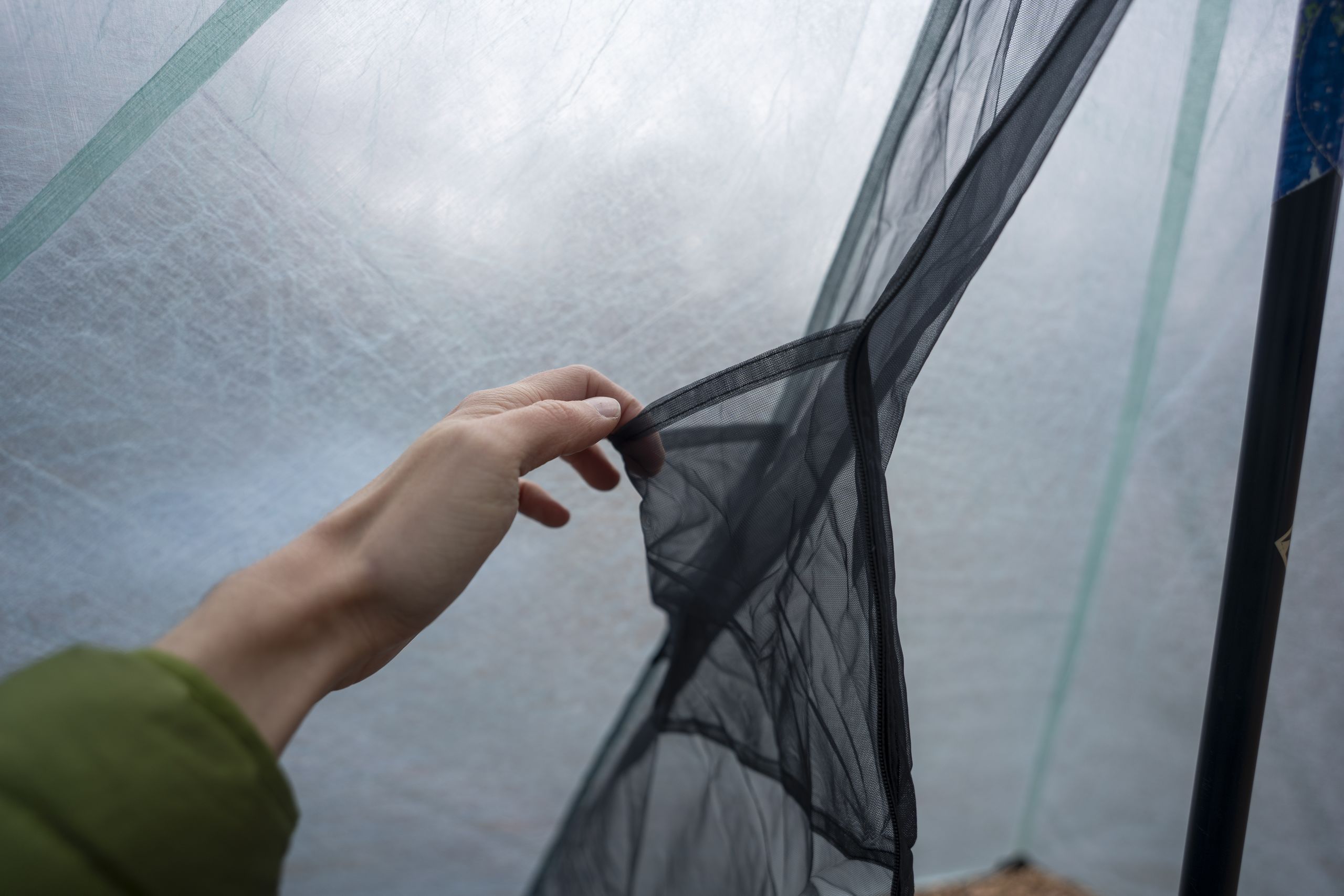
What Other Ultralight Tents Should You Consider?
If the Durston X-Mid Pro 1 Tent is the perfect fit, our best ultralight tents guide has many other options.
Zpacks Offset Duo Review: No tent comes closer than the Offset Duo to rivaling the Pro 2+ for what it does best. The Offset Duo stole our hearts during testing by offering an incredible blend of legitimate comfort for two, excellent features, and similar durability. In many ways, the editor’s choice award could have easily gone to the Offset Duo. Both tents set out to create a truly comfortable experience for two people at a great weight, and they solved certain design challenges in slightly different ways. And at the end of the day, the Offset Duo isn’t a factually worse tent than the Pro 2+, it’s simply a different experience, and one we’d enthusiastically recommend for anyone interested. To our style of backpacking, we still prefer the Pro 2+, but if you’re not quite as taken with it as we are, the Offset Duo should be the next tent you give your attention to, it’s truly incredible.
Lanshan Pro 2 Review: If the price of the Pro 2+ is a bit too much for you, our favorite budget tent is to the rescue. With a total weight of 32.3 ounces, it’s not as featherweight as the Pro 2+, but still boasts decent livability. It’s roomy for an A-frame style tent, even for taller people, and although pitching isn’t quite as straightforward, we still managed to get a great pitch on the first try. The weather resistance won’t be as good due to larger fabric panels on the head and foot end, and the trekking poles are in the middle of the doors, but overall, we still came away impressed during testing. And for the price, it’s really hard to beat.
